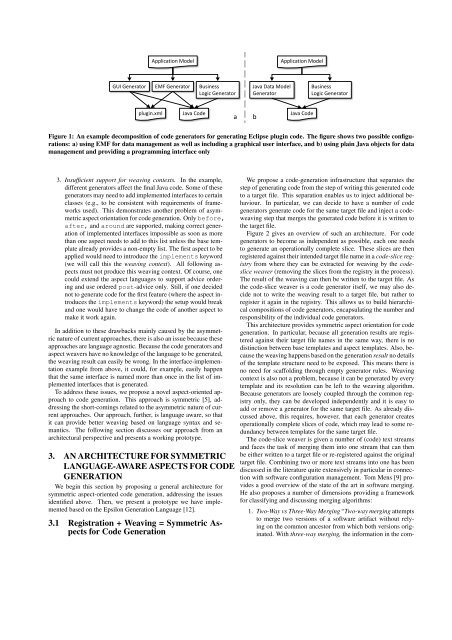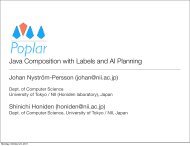all FREECO11-workshop-papers.pdf - trese
all FREECO11-workshop-papers.pdf - trese
all FREECO11-workshop-papers.pdf - trese
You also want an ePaper? Increase the reach of your titles
YUMPU automatically turns print PDFs into web optimized ePapers that Google loves.
Application ModelApplication ModelGUI GeneratorEMF GeneratorBusinessLogic GeneratorJava Data ModelGeneratorBusinessLogic Generatorplugin.xmlJava CodeabJava CodeFigure 1: An example decomposition of code generators for generating Eclipse plugin code. The figure shows two possible configurations:a) using EMF for data management as well as including a graphical user interface, and b) using plain Java objects for datamanagement and providing a programming interface only3. Insufficient support for weaving contexts. In the example,different generators affect the final Java code. Some of thesegenerators may need to add implemented interfaces to certainclasses (e.g., to be consistent with requirements of frameworksused). This demonstrates another problem of asymmetricaspect orientation for code generation. Only before,after, and around are supported, making correct generationof implemented interfaces impossible as soon as morethan one aspect needs to add to this list unless the base templatealready provides a non-empty list. The first aspect to beapplied would need to introduce the implements keyword(we will c<strong>all</strong> this the weaving context). All following aspectsmust not produce this weaving context. Of course, onecould extend the aspect languages to support advice orderingand use ordered post-advice only. Still, if one decidednot to generate code for the first feature (where the aspect introducesthe implements keyword) the setup would breakand one would have to change the code of another aspect tomake it work again.In addition to these drawbacks mainly caused by the asymmetricnature of current approaches, there is also an issue because theseapproaches are language agnostic. Because the code generators andaspect weavers have no knowledge of the language to be generated,the weaving result can easily be wrong. In the interface-implementationexample from above, it could, for example, easily happenthat the same interface is named more than once in the list of implementedinterfaces that is generated.To address these issues, we propose a novel aspect-oriented approachto code generation. This approach is symmetric [5], addressingthe short-comings related to the asymmetric nature of currentapproaches. Our approach, further, is language aware, so thatit can provide better weaving based on language syntax and semantics.The following section discusses our approach from anarchitectural perspective and presents a working prototype.3. AN ARCHITECTURE FOR SYMMETRICLANGUAGE-AWARE ASPECTS FOR CODEGENERATIONWe begin this section by proposing a general architecture forsymmetric aspect-oriented code generation, addressing the issuesidentified above. Then, we present a prototype we have implementedbased on the Epsilon Generation Language [12].3.1 Registration + Weaving = Symmetric Aspectsfor Code GenerationWe propose a code-generation infrastructure that separates thestep of generating code from the step of writing this generated codeto a target file. This separation enables us to inject additional behaviour.In particular, we can decide to have a number of codegenerators generate code for the same target file and inject a codeweavingstep that merges the generated code before it is written tothe target file.Figure 2 gives an overview of such an architecture. For codegenerators to become as independent as possible, each one needsto generate an operation<strong>all</strong>y complete slice. These slices are thenregistered against their intended target file name in a code-slice registryfrom where they can be extracted for weaving by the codesliceweaver (removing the slices from the registry in the process).The result of the weaving can then be written to the target file. Asthe code-slice weaver is a code generator itself, we may also decidenot to write the weaving result to a target file, but rather toregister it again in the registry. This <strong>all</strong>ows us to build hierarchicalcompositions of code generators, encapsulating the number andresponsibility of the individual code generators.This architecture provides symmetric aspect orientation for codegeneration. In particular, because <strong>all</strong> generation results are registeredagainst their target file names in the same way, there is nodistinction between base templates and aspect templates. Also, becausethe weaving happens based on the generation result no detailsof the template structure need to be exposed. This means there isno need for scaffolding through empty generator rules. Weavingcontext is also not a problem, because it can be generated by everytemplate and its resolution can be left to the weaving algorithm.Because generators are loosely coupled through the common registryonly, they can be developed independently and it is easy toadd or remove a generator for the same target file. As already discussedabove, this requires, however, that each generator createsoperation<strong>all</strong>y complete slices of code, which may lead to some redundancybetween templates for the same target file.The code-slice weaver is given a number of (code) text streamsand faces the task of merging them into one stream that can thenbe either written to a target file or re-registered against the originaltarget file. Combining two or more text streams into one has beendiscussed in the literature quite extensively in particular in connectionwith software configuration management. Tom Mens [9] providesa good overview of the state of the art in software merging.He also proposes a number of dimensions providing a frameworkfor classifying and discussing merging algorithms:1. Two-Way vs Three-Way Merging “Two-way merging attemptsto merge two versions of a software artifact without relyingon the common ancestor from which both versions originated.With three-way merging, the information in the com-




